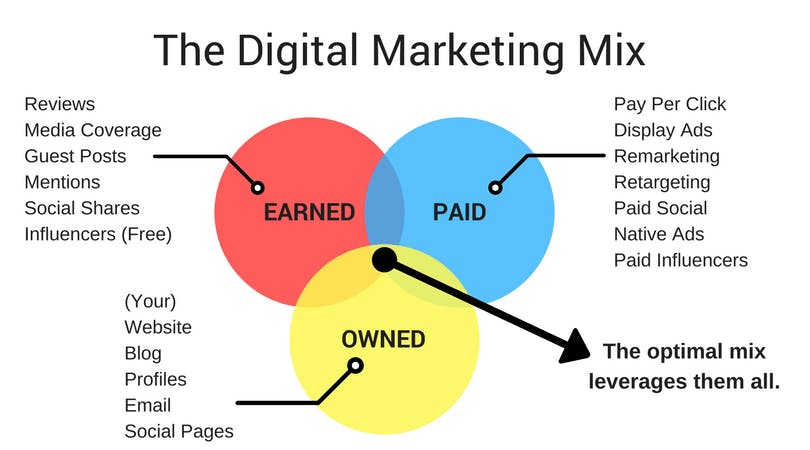The Marketing Mix: 4Ps & 7Ps of Marketing
Product, Price, Place, Promotion.
If you read the first line and thought “ah the 4ps of marketing”, then you probably know a thing or two about the marketing mix. And if you really know this model, you’ll know there are three more: People, Process, and Physical Evidence. But maybe you're wondering, what even is the marketing mix?
Before we answer that question, let’s go back to basics and understand where the term came from; marketing. As many modern marketers have learned, the foundation of marketing is putting the right product in the right place, at the right price, at the right time. Simple right? The hard part is doing it well.
Marketing is all-encompassing as it’s present in all stages of the business cycle: market research, analysis, product development, distribution methods, sales, and understanding your customer’s interests. And marketers use campaigns as a way to execute this journey.
So, what is a marketing mix exactly? Read ahead to learn what it is and why it’s important to master as a marketer.
Marketing Mix, Explained
Organizations have always used marketing solutions to “sell” their work, with this mix being one of them. To set the foundation, the marketing mix definition states a set of marketing tools a business uses to promote a company’s brand or product in the market. And traditionally, the model was built from the 4ps of marketing: Product, Price, Place, and Promotion, but as marketing evolved, as did the strategy. With People, Process, Physical Evidence as additions, expanding to 7ps.
Businesses methodize the elements of a marketing mix to drive marketing decisions at every level. It helps them:
- Identify its strength and limit its weaknesses
- Become more competitive and adaptable
- Improve collaboration between department and partners
But before you start using the ps of the marketing mix, you need to decide the persona of your target audience. Understanding the details of who you are selling to, will help you determine the details of your mix. You can’t get started without this.
Marketing Mix 4ps
The 4ps are the foundation of the idea of the mix and have been used since the 1960s. The 4ps stand for:
- Product
- Price
- Place
- Promotion
Marketing Mix Product
This simply, is what is being sold. When we talk about the product, we mean elements like quality, packaging, design, and brand. In developing the product, you must ensure it meets the demand for your market, aka does your target market wants or need this?
The life cycle also must be considered in this stage, which includes the growth, maturity, and sales decline phase. Offering a better product to your target audience over your competitors will ultimately allow you to take home the win for this element.
Here are 5 questions that will help define this element:
- What does the customer want from the product/service?
- How and where will they use it?
- What are the must-have features to meet the client’s needs?
- Does the product have a catchy name?
- How is your product different from your competitors?
Marketing Mix Price
Come on down and play the price is right! Well, kind of, just for marketing.
In the mix, price refers to the price your customer is willing to pay. Hello, product value!
The price inherently must be higher than the cost of production, as this determines your profit or survival. And adjusting the price not only has a big impact on the sales and demand for the product but also, ultimately shapes the perception of your brand.
Tip: A lower price is associated with inferior products, especially when consumers are comparing your prices alongside your competition. Consequently, pricing too high can result in costs outweighing the benefit. Where’s the sweet spot?
So when setting the price, marketers should consider the value the product offers and evaluate different pricing strategies.
Answer these 5 questions to help get started with this element:
- Is this priced favorably?
- How does the price compare to competitors?
- Should discounts be offered?
- Do you accept payment plans?
- Are there any credit terms the customer might need to meet?
Marketing Mix Place
Place refers to the distribution and availability of your product for potential customers.
And you can’t talk about the place without talking about your target audience. This element comes with a deep understanding of the target persona. Once you have mastered knowing the ins and outs of your target customers, you will discover the most efficient distribution channels.
So how do you put your product in the right place? Here are 5 questions that will help define this element:
- Where do buyers look for your product?
- How do you access the right distribution channels?
- How is your distribution strategy different from competitors?
- Do you need to use a sales force?
- Do you need to sell online?
Marketing Mix Promotion
Get the word out!
Promotion means who, what, and how. What is communicated, who it is communicated to, how that audience is reached, and how often promotion happens. Its methods like:
- Advertising
- Sales
- Public Relations
- Emails
- Social Media
Its main purpose is to boost brand recognition and sales. Nail these 5 questions, and you’re on the road to a promotion strategy:
- Where and when can you get your marketing messages across to your target market?
- How do your competitors do their promotions?
- And how does your competition influence your choice of promotional activity?
- When is the best time to promote your product?
- Is it best to use social media?
Marketing Mix 7ps
Sometimes, the 4ps can be expanded to the 7ps: People, Process, and Physical Evidence. The 7ps help a company define gaps that affect the marketing of its product.
Let’s take a look at the details.
Marketing Mix People
Businesses are reliant on the people who run them, right? So it’s a no brainer having the right people is essential as they are as much a part of your business offering as the products/services you are selling. This includes things like employee performance, appearance, and customer service.
So determining what makes up the ”right people” for your business can vary, but it should encompass these three aspects:
- Quality service
- Genuine passion
- Open to feedback
Tip: Having the right people is an internal advantage that affects your position in the market.
Marketing Mix Process
The process is the how in which your product or service is delivered to customers. It can be your sales funnel, a distribution system, and other systematic procedures to ensure your business is running effectively. And you want to make sure that your process is well organized to minimize costs.
Other examples include the order in which employees perform tasks, the number of queries salespeople receive, or how performance is tracked and measured.
Marketing Mix Physical Evidence
Physical evidence can be tangible or intangible and there should be evidence that the service was delivered. A tangible example is product packaging, receipts, or contact experience. Intangible physical evidence is the perception of a business’s product in the marketplace.
Consistent branding across communication channels is a way to influence consumers’ perceptions, to the point where when they hear a word, sound, or phrase, your brand is the first thing to come to mind. For example, when you think of fast food, who do you think of? Most people will say McDonald’s. You instantly know their presence in the marketplace. Ding ding intangible physical evidence!
Now that we have all of the ps covered, let’s move on to how it’s applied to the digital landscape.
Digital Marketing Mix
This is how a business achieves its marketing goals using digital technologies. And as more business is done online, digital marketing solutions become more and more popular.
Paid, owned, and earned media are the ingredients needed for a great digital marketing mix and should make up your marketing reports. Simply put, by categorizing your efforts into paid, owned, and earned media you identify how your content achieves a seat at the audience table.
It looks something like this:

*Source: Search Engine Journal
Paid Media
Here, you’re paying for visibility or exposure to a particular audience on a platform that you don't own. It allows you to get in front of a new audience more quickly than organic strategies but they can only stretch as far as your budget allows. Examples include:
- PPC
- Paid social
- Display
- Paid influencers
- Native advertising
Owned Media
This refers to marketing that occurs on any property that you own and control. The great part about this is you get to include the content you want your customers to see. Examples include:
- Website
- Blog
- Profile
- Social pages
Earned Media
Here you have little to no control. This is another’s property that offers you free placement in front of a new audience (i.e., someone else says something about you for “free”). In the early days, this was referred to as Public Relations but has expanded with all the digital platforms available.
The great part about earned media puts you in front of a new audience without paying for it. The caveat is that you don’t have control over the messaging. Examples include:
- A publication covering a story about your brand
- Social media share
- Customer story
All three of these areas help you understand your financial efficiency and how you stack up against your competition.
What’s Next?
By now you should really understand what the marketing mix is. You might be wondering if you’re using the strategy correctly or even how to use it for your business if it is new to you. Well, start by thinking about what percentage of each element of the 7ps make up your marketing mix.
We have one last thought...is there an 8th p?





You have provided valuable data for us. It is great and informative for everyone. Read more info about Market Evaluation Consulting Edmonton Keep posting always. I am very thankful to you.
ReplyDeleteI appreciate your efforts which you have put into this article. This post provides a good idea about a hr>branding design Jakarta</a Genuinely, it is a useful article to increase our knowledge. Thanks for sharing such articles here.
ReplyDeleteVery well written article. It was an awesome article to read. Complete rich content and fully informative. I totally Loved it.Social Media Plan for New Business USA
ReplyDeleteClearly, It is an engaging blog for us that you have provided here about outsource digital marketing services in india This is a great resource to enhance our knowledge about it. Thank you.
ReplyDelete